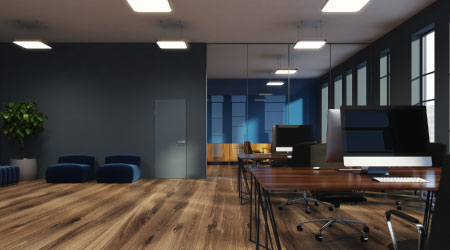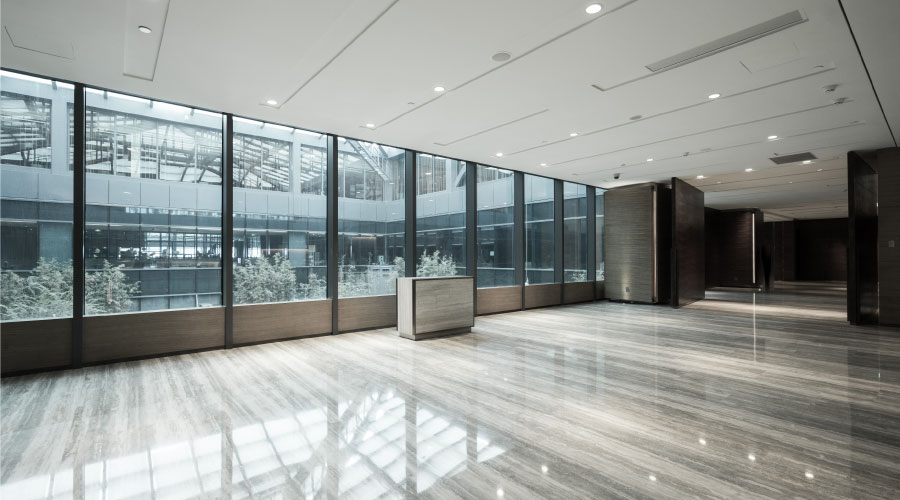Floor Installation and Maintenance
4. INSTALLATION The quality of installation is as important as the flooring material itself. When using sheet vinyl products, it is imperative the substrate be tested for moisture vapor emission. Installation failures due to moisture are at epidemic levels and can cost five to 10 times the cost of the original installation to correct, not to mention down time and business interruption. Always make sure the substrate gets tested regardless of the circumstances; testing should never be considered an optional step. Given that sheet vinyl is widely used in hospitals, other health care facilities and schools, it is especially important for facility managers responsible for such facilities to ensure that moisture testing is done.
The space in which the flooring material is to be installed, regardless of the material, must have the HVAC system operating as it would be if the building were occupied. This is particularly critical for wood flooring of any kind to avoid changes such as cupping, doming, cracks and gaps. A rule of thumb is that if it's comfortable for humans it's comfortable for the flooring.
After the substrate and ambient conditions have been deemed appropriate for the flooring material, it's time to find the right people to install it. Qualify them by asking questions. There's nothing wrong with asking the installation firm to provide proof they can do the job and have experience. If they balk at this suggestion, don't use them. Make them provide their certification, demand a minimum of years in the trade and ask them to provide a list of similar jobs. If they are true commercial installation professionals this will be an easy task and they'll be happy to comply. Also, look to groups like Starnet, ReSource and CFI (Certified Flooring Installers) and installers trained and certified by INSTALL to be the cream of the crop. Another step is to ask the manufacturer for references — installation firms they know and trust.
Facility managers should always make sure to check the installation firm themselves. This will help avoid a multitude of problems and help ensure the right product, in the right place, installed by people who know what they're doing and will guarantee the work.
5. MAINTENANCE Anything installed has to be maintained. That's one reason to make sure the right product is installed in the right place. Any flooring material that retains its appearance will protect the investment and keep the maintenance budget in line.
All types of flooring have to be maintained. This means establishing a program that includes — depending on the flooring material — vacuuming, mopping, sweeping, dusting, spot cleaning, interim cleaning and overall cleaning.
One common problem is dust, which will accumulate on the floor daily. Carpet will hide this type of soil but hard surface floors will magnify it. There is a difference in maintenance costs so this will also have to be considered.
One other thing to keep in mind is protecting the entrances to the facility. This is where all the soil and grit will come from. Without good entry-area protection, soil of all kinds will be tracked into the space and compromise the appearance and integrity of the flooring materials. The least expensive part of the equation, the entry-area protection, can prevent major problems with the flooring. Nothing says the owner doesn't care like dirty flooring, and dark spots and spills say that best. But if it's clear that the owner and facility manager care about the flooring, then tenants and occupants will as well. 
Lewis Migliore is president of LGM and Associates, which offers technical flooring services. Contact him at lgmtcs@optilink.us.
CERTIFICATION
Sustainable Resilient Flooring
A new certification program offers facility managers an indicator of the sustainability of resilient floor coverings. "Sustainability Assessment for Resilient Floor Coverings" was developed by NSF International and has been adopted as an American National Standard.
The standard looks at six categories related to resilient flooring products: design, manufacturing, long-term value, end-of-life management, corporate governance and innovation. Products can be certified at four levels: conformant, silver, gold and platinum. The standard covers vinyl, rubber, linoleum and polymeric floor coverings, as well as accessories like wall base, moldings and stair treads.
The new certification program traces its roots back to 2006, when the Resilient Floor Covering Institute and NSF teamed up to begin work on a sustainability assessment. The standard — formally known as NSF/ASNI 332-2010 — was developed by NSF and drew input from end users, manufacturers and regulators, according to NSF.
— Edward Sullivan, editor
|
Related Topics:














